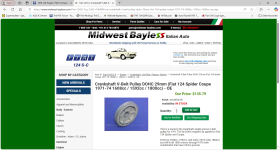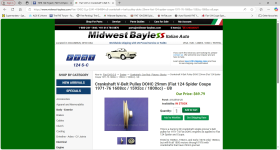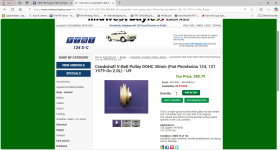Thanks! The socket is an impact, I grabbed it as I wanted a deep...just wanted to mention the advice you gave about when replacing a part to consider the reinstall is very true, removed the fuel pump yesterday, from the top per twink80s advice which I'm convinced is the best way to go...removal took 5 minutes, install of the new one today took 2 hours with finding what tool combo fits the tasks and the tight squeeze on everything, great advice to always consider!
The reason I kept talking about needing a shallow socket and describing the factory wrench was I am more familiar with Euro spec. engines, these have a shallower pulley without the extra V belt grooves that drive the ac compressor and air pump (if fitted) on U.S. spec cars. The factory crank pulley nut wrench was designed to allow the engine to be turned over in situ and with the radiator still in place, including when replacing the timing belt. (In the Fiat Dealership where I worked, we usually didn't remove the radiator when replacing just the t/belt, just disconnected the top coolant outlet from the head to allow removal of the timing belt cover).
Here's some views of the early Euro style shallow crank pulley :-


And here's a pic of the U.S. spec. crank pulley which is much deeper due to the additional V belt drive grooves :-

I've only worked on a very small number of 124 Spiders imported here from the 'States and usually all the 'smog' gear then gets removed pronto. Plus, much of this experience is now 40 - 45 years ago (i.e. in the last century), so apologies if my memory sometimes fails me or I misremember some things - I'm always happy to be corrected,

as I wouldn't want to inadvertently continue to spread incorrect information.
One tip about refitting parts e.g. fuel pumps in a confined space would be to possibly attach the fuel hoses to the pump before refitting it, ensuring that you position the hose clamps so that they can be re-tightened if necessary (i.e. think of where the screws heads will be pointing when installed, can they still be easily accessed?).
Another possible tip, I prefer to use 3/8" sq. drive socket etc. for jobs such as these, they're strong enough to cope and not so big as to risk over-tightening fasteners (i.e. BOLTS & NUTS

)('cos I'm so strong

).
I also make use of 'stubby' wrenches if the fasteners are unlikely to be too tight.




